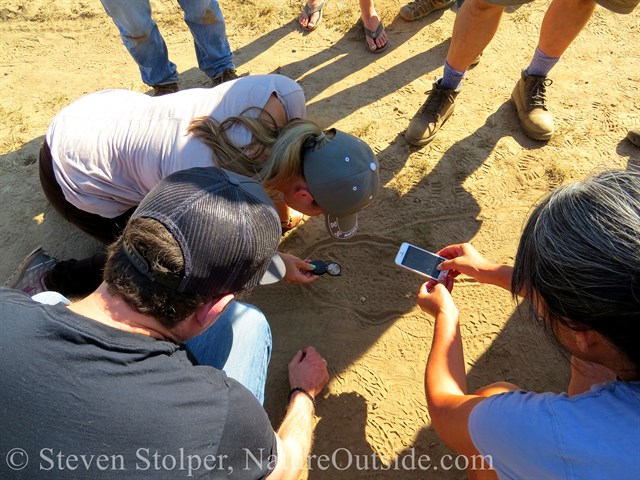
At the start of my professional career, my job was to explore the planet Mars.
I was so happy! Mars is cool! It’s the frontier of human knowledge. Earth is boring! Scientists must already know everything there is to know about it. After all, if we want to learn about our own planet, we just need to step outside.
I was wrong, of course. For an “Advanced Species,” we don’t know much at all about nature. It’s shocking when you consider how little we understand our planet, and the animals with which we share it.
Our ancestors were far more connected to nature than we are today. Ancient man viewed himself as a part of nature, not apart from it. He was a keen observer of the natural world.
Much of our first-hand knowledge of the natural world has faded. Replaced by digital logic and “deep learning.” True we have the scientific method, but we lack the observations to feed it.
So, when you ask even a simple question about nature, you may be startled by the answer: We don’t know! Or worse, the answer is flat-out wrong!
That’s what happened to me today. And it’s a good reminder that we shouldn’t believe everything we read…
This post contains affiliate links.
Out with the Trackers
We set out promptly at 8:00 am. Our group of Bay Area Trackers have two objectives: Beat the heat, and beat the mountain bikers!
For a variety of reasons, I’m not a fan of how mountain bikes affect local wildlife. But one obvious consequence is that they scour the trail of track and sign. So we always start early, before the first cyclists appear.
It’s especially important today. We are visiting an open space preserve known by trackers for its wonderfully fine dust. It will be our last visit before the winter rains return. And we’re eager to take advantage of the ideal conditions.
Great Horned Owl Tracks
The find of the day is a set of Great Horned Owl tracks. The Great Horned Owl (Bubo virginianus) is what most people think of when they hear “owl.” It has all the accoutrements. It’s big, with large ear tufts (plumicorns), and that intimidating yellow-eyed stare. You may have heard its deep hooting voice: hoo, hoo-hoo, hoo, hoo.
It’s a predator that dines on birds, mammals, and large insects. Several in our group have seen tracks before. The owl apparently spends some time on the ground.
I’m impressed by my companions’ the sharp eyes. I would have walked right past the tracks. Can you see them in the pictures below?
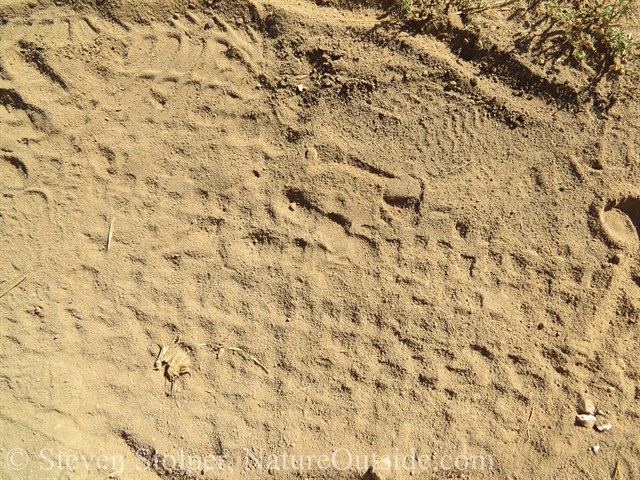
Can you spot the Great Horned Owl track?
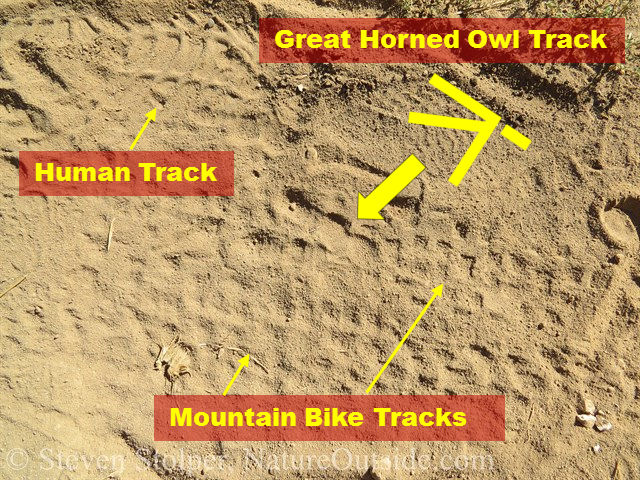
The tracks are easy to miss. The track pictured is four inches long. Note that my depiction does not quite match the orientation of the track.
Even close up, the tracks are hard to see.
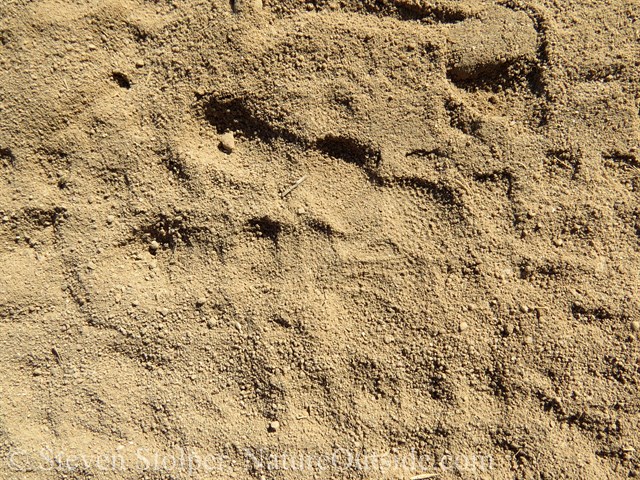
Great Horned Owl Track (left)
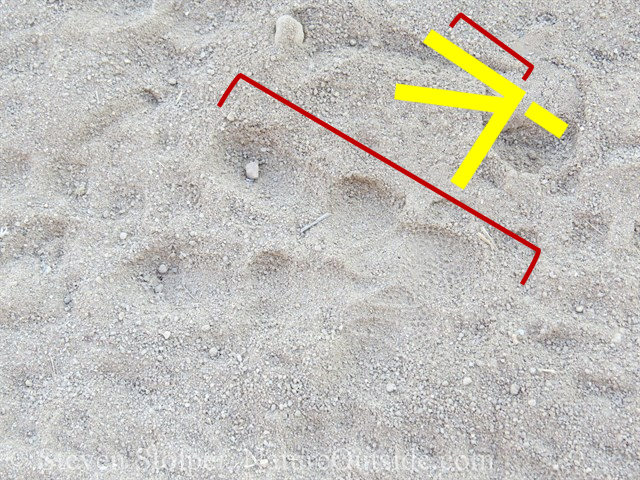
Great Horned Owl Track (annotated)
Owls are zygodactyl. Many birds have three forward-pointing toes and one that points backward. But owls have two toes pointing forward and two that point to the rear. I look for the distinctive “Special K” cereal logo on the ground.
These tracks are four inches long. That’s a big bird! The size distinguishes Great Horned Owl tracks from others that live in our area.
For me, the most intriguing part of the tracks are the dimples. If you look closely at the “heel” of the track, you will see definite stippling. You can also see a little at the base of the fourth toe, the one that points sideways.
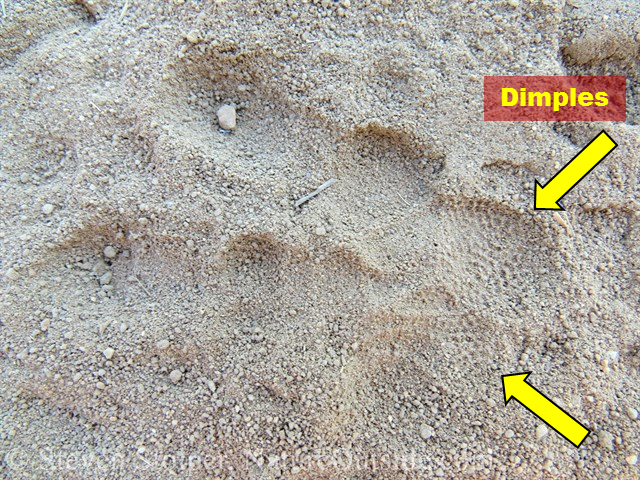
The dimpling is visible in the “heel” of the track and one of the pads of toe 4.
Owls have papillae-like knobs on the bottom of their feet. I have heard several explanations for their use. One tracker told me that the feet are so sensitive that an owl can tell if its prey’s heart is still beating. The information I found in my quick search suggests that owls use the rough surface on their soles to help them grip prey animals and perches. Another source suggests that the soles are supplied with extra blood vessels to help radiate heat. I was unable to find a comprehensive description of owl feet.
Don’t Believe Everything You Read
Don’t just teach your children to read…
Teach them to question what they read.
Teach them to question everything.
― George Carlin
I’m puzzled by something that doesn’t look quite right. There are several tracks, so I project the center-line of the animal. The toes aren’t oriented the way I expect. So I examine the best track in the set and ask a common question: Am I looking at a left or a right?
My answer doesn’t agree with my expectation. So I whip out my favorite reference, Elbroch’s Animal Tracks and Scat of California. In the book is a picture of a left track.
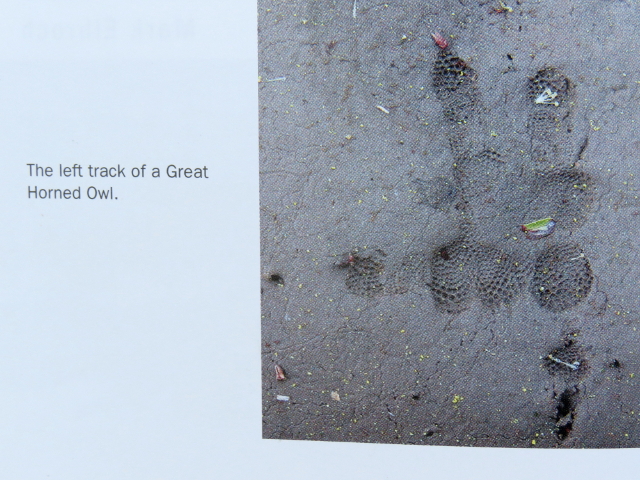
Picture of a left Great Horned Owl Track in my reference book.
I’m looking at a left track. Toes three and four point away from the center of the animal. This is the opposite of what I was thinking.
My ego smarts momentarily. I’ve made a mistake. But this is how you learn.
I was wrong today, but I won’t be wrong tomorrow. Neil deGrasse Tyson, Director of the Hayden Planetarium, says he’s happy when he makes a mistake. Because that means he’s learned something new.
As I’m processing the new information, I notice a tracker beside me consulting a laminated card. It’s called “Local Tracks of North America.” I can’t resist a peep over his shoulder.
To my amazement I see this:
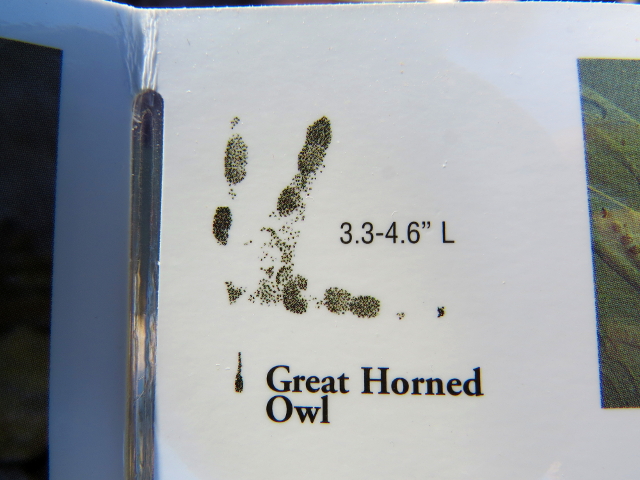
Great Horned Owl Track from laminated card. I believe the track is mislabeled.
This is the exact opposite from the picture in my book! One of them must be wrong.
Let the Track Teach
My instinct is to believe Elbroch. But I was surprised by such a discrepancy on an “in your face” physical fact.
I took my dilemma to an experienced tracker in our group. He looks me in the eye and says, “Let the track teach.”
Let the track teach.
– Experienced animal tracker
Of course, he’s right! All the information we need is in the tracks in front of us. Believe what the tracks tell you. Or, as the younger generation says, “Track don’t lie!”
Puzzling through the tracks, we confirm that my book is correct. The track on the card doesn’t agree with the owl. The card is most likely mislabeled.
This is actually the second error I found in a reference this week. The other one was in a “wilderness survival manual.” There, simple geometry unearthed the error.
The moral of the story is to always read natural history information critically. Question. Reason. Don’t take a reference at face value.
I often encounter errors in books on wild edible and medicinal plants, where the consequences of an error can be severe. Often the author is repeating a mistake made by an earlier text he’s read. So I always read information with a critical eye.
But often we just don’t know. So question. Reason… And don’t believe everything you read.
Have you found any errors in field guides or references? I’d love to hear about them in the comments below.
References
Great Horned Owl (All About Birds)
Related Articles on NatureOutside
Stalking the Black Bear – High Adventure in the Forest (Part 1)
Mountain Lion Tracks – Learn to Read Them
Wolves Teach a Master Class (Part 1)
For fun facts and useful tips, join the free Bushcraft Newsletter.



If you simply look at pictures of Great Horned Owls on perches and gloves you can see that they hold their feet both ways depending on the situation, and most modern sources say as much. Acorn Naturalists literally has a track mold with both toe orientations 😐
I was unaware of this and will take a look at some pictures of perched owls.